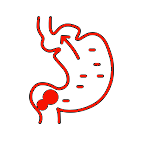
Laproscopic hernia
A hernia occurs when part of your insides bulges through an opening or weakness in the muscle or tissue barrier that contains it. The majority of hernias involve one of your abdominal organs pushing through one of your abdominal cavity's walls. Hernias can develop gradually as you age and the regular wear and tear on your muscles adds up. They can also be caused by an injury, surgery, or a birth defect.
Hernia Surgery is the procedure to repair the weakened muscle wall that has a hole in it and push the herniated organ back into its original location. There are two approaches to the treatment.
- Herniorrhaphy is a treatment that involves repairing the wall without using any support. Hernioplasty is the procedure that uses mesh to support the muscle wall and provide reinforcement while it heals.
- A laparoscope, a thin, telescope-like instrument inserted through a small incision at the umbilicus, is used in laparoscopic (minimally invasive) hernia repair (belly button). The laparoscope is linked to a dime-sized video camera that projects a inside view of your body onto television screens in the operating room.
Symptoms
- A lump or bulge in the affected area is the most well-known symptom of a hernia.
- An obvious swelling under the abdomen or groin's skin; it may disappear when you lie down, and may be tender.
- Abdomen or groin discomfort when lifting or bending over. Diagnosis
You may be unaware that you have a hernia unless it is discovered during a routine physical or a clinical test for hernia for an unrelated issue. Some common diagnostic tests include:
- Abdominal ultrasound
- CT scan
- MRI scan
Doctor may use some other tests that allow them to evaluate the internal area of your abdomen:
- Barium X-Ray
- Endoscopy
Benefits of laparoscopic hernia surgery include:
- Tiny incisions are made on the abdomen
- The procedure is carried out while the surgeon watches high-resolution images of the patient's abdomen on a monitor.
- Less post-operative pain
- Earlier return to work
- Positioning the mesh on the inside of the defect is mechanically superior to placing it on the outside as in the non-keyhole operation
- Hernias on both sides can be repaired through the same three holes as opposed to open surgery where a separate incision on the other side is required
Make an appointment right away for consultation on any signs and symptoms noticed
Call With Doctor